Volkswagen Taigun: what is it?
The Taigun isn’t Volkswagen’s first SUV in India but it sure is its most important one yet. Because, unlike the Tiguan, Tiguan AllSpace and T-Roc that operate in the premium and niche segments, the Taigun is here to make a mass impact in the big volumes midsize SUV segment. As you might know already, the Taigun is closely related to the Skoda Kushaq, with the midsize SUVs being the first models to come from the Volkswagen Group’s ambitious India 2.0 programme.
Like the Kushaq, alongside which it was developed and is manufactured, the Taigun is built on the ‘Indianised’ MQB A0 IN platform and boasts of up to 95 percent local components. The Taigun range starts with the 115hp, 1.0-litre turbo-petrol engine that can be had with a 6-speed manual or a 6-speed torque converter auto gearbox. However, it’s the spicier ‘GT’ variants that are the focus of this review. The Taigun GTs are exclusively available with a 150hp, 1.5-litre turbo-petrol engine with a standard-fit 6-speed manual or 7-speed dual-clutch automatic option.
What’s interesting is that the GT manual and GT automatic are specced very differently. A Volkswagen official revealed that the carmaker wants to make the GT manual “more accessible”, whereas buyers looking to get an automatic usually aren’t averse to shelling out a larger premium for the sake of convenience and equipment.
Volkswagen Taigun: what is it like on the outside?
First things first, the Taigun isn’t the largest of the midsize SUVs on sale in India. Slightly shorter and narrower than a Hyundai Creta, the Taigun doesn’t quite have the butch road presence that many buyers might associate with an SUV. That said, the Taigun is chic and contemporary and is attractive in the metal.

The look is unmistakably Volkswagen, with clean lines and an unfussy design language. The three-slat chrome grille that sports an oversized VW logo seamlessly blends into the large headlamp clusters, while the raised, squared-out bonnet immediately links the Taigun to the more premium Tiguan. There’s a generous use of chrome up front that’s said to have been incorporated in line with Indian tastes. However, if you like your German cars understated, you’ll find there’s too much bling on the Taigun.
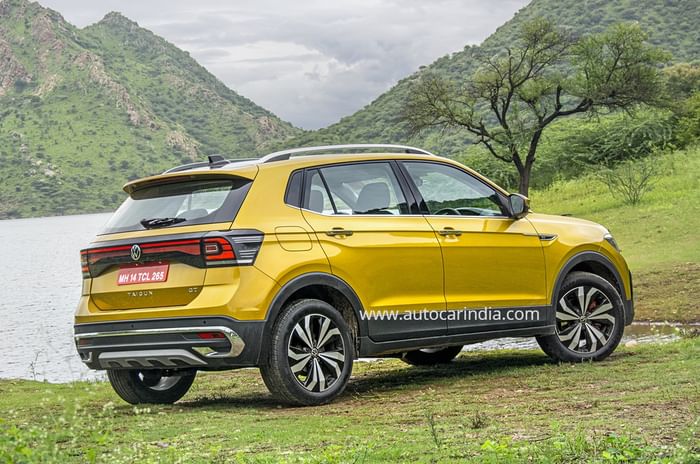
The Taigun has a clean-cut silhouette, with the long wheelbase (a class-leading 2,651mm) and short overhang stance most evident in profile. Commendably, it’s only at the sides that you could possibly mistake a Taigun for a Kushaq. The two models share, doors, mirrors, roof rails, shark-fin antenna and even feature the same body cladding. Within the Taigun GT line, the automatic is distinguishable by its 17-inch diamond-cut wheels, while the GT manual makes do with smaller, single-tone16-inchers.
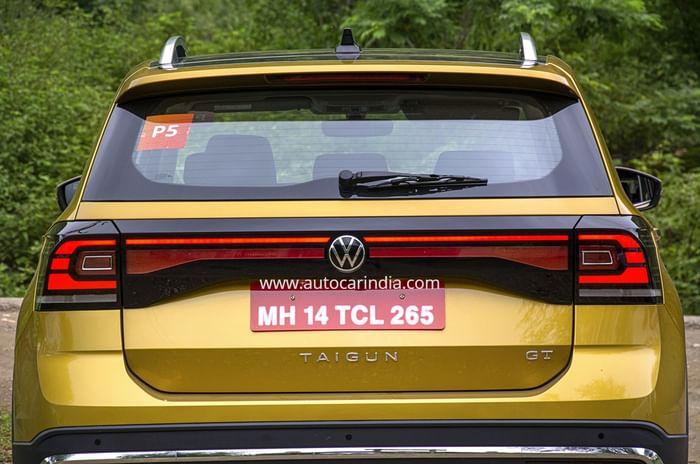
The Taigun’s most distinctive angle is its tail-end. Nestled in a large, smoked bezel sit attractive LED tail-lamps that are linked by a functional light bar, which runs the width of the tailgate. The tail-lights look particularly attractive when lit and appear off of a futuristic concept vehicle. Adding more flash at the back are the chrome embellishments on the rear bumper that are designed to mimic twin exhaust housings.
Volkswagen Taigun: what is it like on the inside?
The Taigun makes a positive first impression the moment you shut the door, which closes with a reassuring thud, something we’ve come to associate with VW cars. Inside, you’ll find yourself in a very modern Volkswagen cabin. The dashboard is particularly nice, with a seamlessly integrated, high-set touchscreen and a pleasing mix of materials. There are no soft-touch plastics on the dash but faux carbon-fibre inserts and a ceramic-like panel on the fascia add some personality inside. Interestingly, the gloss panel is also available in red with certain body colours – vibrant or overkill, it’s a detail that will divide opinion.
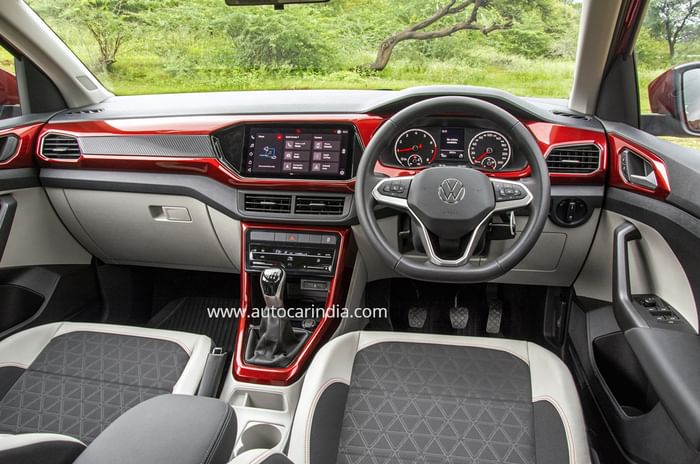
Adding more colour to the cabin is the 8.0-inch coloured digital instrument cluster that’s part of the package on the GT auto. While attractive and easy to read, it’s not a widescreen unit like Audi’s Virtual Cockpit; only the central screen (out of the three) is configurable, while the ones on the side are dummies. The GT manual version has simpler analogue dials with a rather basic monochrome MID. Other nice bits include the very sporty flat-bottomed steering wheel and the touch-operable climate control panel, which looks premium and is easy to use.
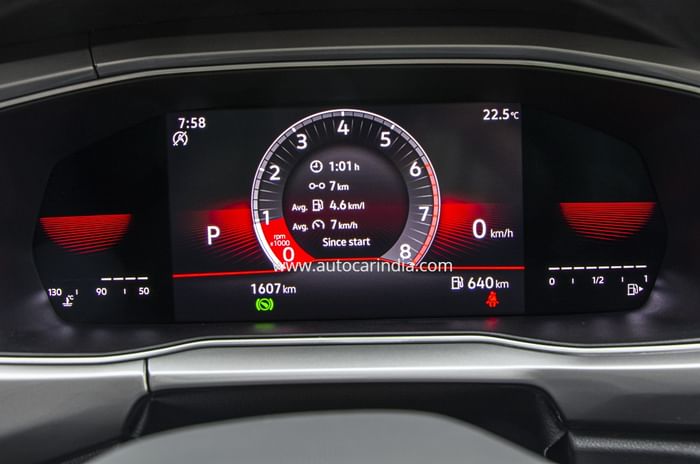
The fit-finish is decent in most places, and even though the plastics are hard, they feel solid and built to last. The cabin experience is, however, dampened by the roof lining, which feels low-rent; the exposed sunroof railings are an eyesore; and the strip of dummy buttons below the touchscreen look out of place in a car of this segment. Also, while the backlit automatic gear selector looks premium, it isn’t perfectly fitted and tends to rock about side to side.
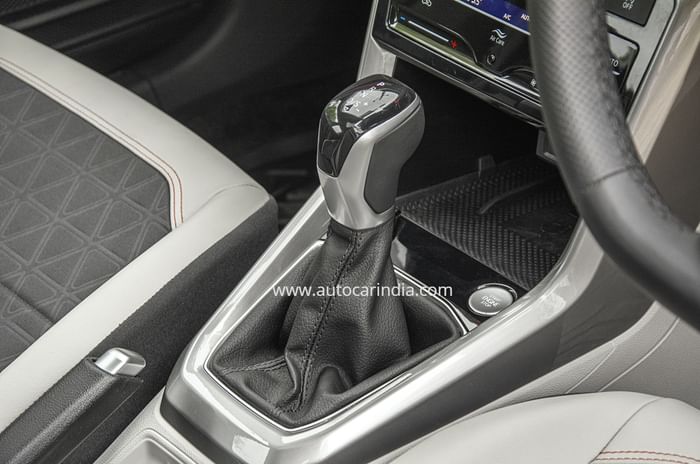
The Taigun GT’s seats are comfy and nicely trimmed, and there’s ample adjustment on offer to find the right seating position. What’s also nice is that the rear seat is spacious and there’s ample light filtering through, thanks to the low window line. The rear bench is supportive and the backrest is nicely contoured to offer a certain degree of lateral support. For India, Volkswagen has reduced the height of the central floor hump (a structure that provides rigidity to the body), added an adjustable head restraint, as well as a three-point seatbelt for the middle passenger. Due to the car’s narrow width, however, this seat is more suited for two adults, than three.
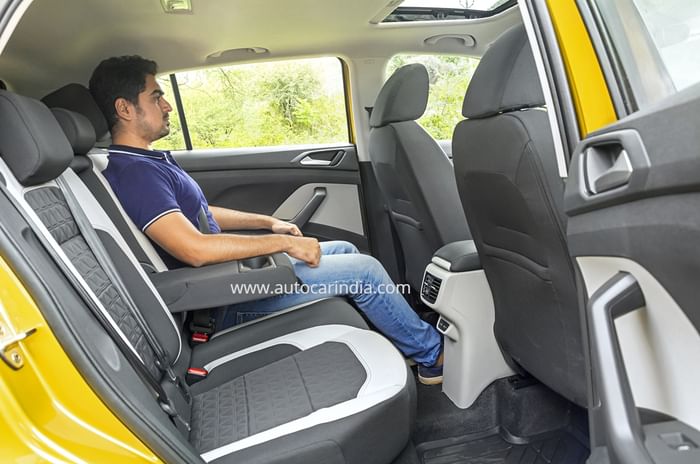
There are plenty of storage provisions across the cabin, like massive door bins, a large wireless charging pad to hold a smartphone, cupholders, seatback pockets, and even the boot is more accommodating than what its 330 litres might suggest. The rear seats split 60:40, should you need more luggage room.
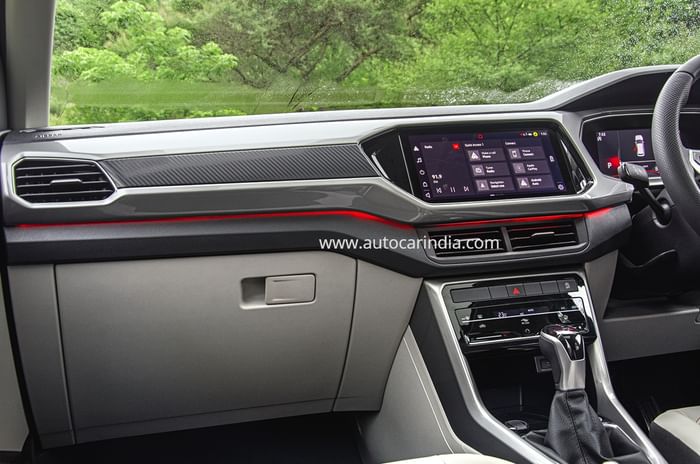
Volkswagen Taigun: what equipment does it come with?
What’s impressive is that all variants of the Taigun get electronic stability control as standard, along with mandatory kit like ABS with EBD, dual airbags and reverse parking sensors.

Volkswagen’s new 10-inch touchscreen is slick to operate, and wireless Android Auto and Apple CarPlay are a welcome inclusion. It also packs in pre-loaded apps such as Gaana that work using your smartphone’s internet. In addition to these, the GT manual is also equipped with a wireless charging pad, climate control, cruise control, 16-inch alloys and a reverse camera. The GT automatic goes a few steps ahead and offers auto LED headlamps, 17-inch alloys, push-button start, auto dimming inside mirror, a digital instrument cluster, sunroof, and side and curtain airbags. Curiously, the non-GT variants also get ventilated front seats, while the GT variants don’t. These are likely to make it in the equipment list further down the line, we’ve been told.
Volkswagen Taigun: what is it like to drive?
The Taigun GTs will be the first port of call for keen drivers. A part of the EA211 EVO engine family, the GT’s 1,498cc turbocharged petrol unit develops 150hp at 5,000-6,000rpm and a max torque of 250Nm at 1,600-3,500rpm. This engine feels energetic right from the get go, and because of the broad spread of max torque lower down the rev range, you can merrily amble around town without paying attention to which gear you’re in. Drive with a heavy foot on the accelerator and the Taigun does build pace rapidly, albeit in a very linear manner. You won’t get that push back into your seat but progress is strong. There is a downside to winding this engine, as it gets quite vocal once the revs cross 3,500rpm, and this boomy character can get quite intrusive on a longer drive.
Relaxed cruising or gentle drives, on the other hand, will activate the engine’s cylinder on demand technology, wherein it shuts off two of its four cylinders to reduce fuel consumption. The system works so unobtrusively that, unless you look at the display on the MID, you won’t even realise when the engine is running on two cylinders. Prodding the accelerator pedal a bit harder has the engine back to firing on all cylinders (pun intended).
The GT auto’s 7-speed dual-clutch transmission is an update version of the DQ200 gearbox, which did duty in the old Polo GT TSI and the previous-gen Octavia 1.8 TSI. What’s nice is that its smooth character remains unchanged. The shifts are seamless and, in D mode, it feels eager to shift to the highest ratio possible in the interest of fuel efficiency; so you’ll often find yourself in fifth or even sixth gear while pottering around town. In Sport mode, it holds the gears a bit longer for crisper, more immediate responses. The Taigun features paddleshifters too and while the gearbox works rather nicely for the most part, you’ll find yourself reaching for the left paddle only when you suddenly put your foot down and the gearbox takes a second or so to react.
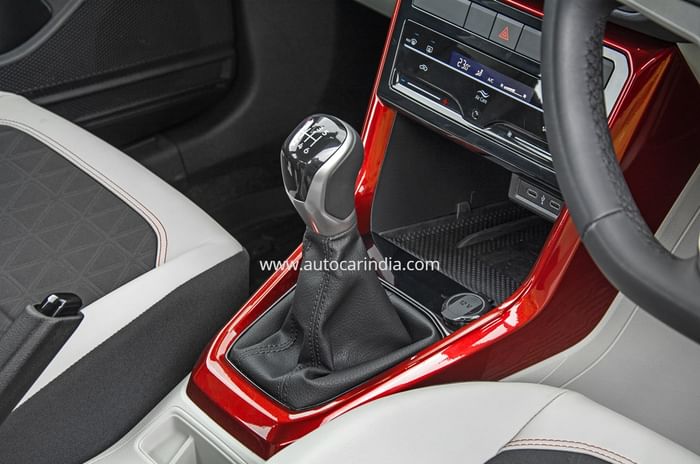
The MQ281 6-speed manual is the one that’ll tug at the heartstrings of driving enthusiasts. The short-throw gearbox is smooth and makes the task of rowing through the gears a breeze. And while the engine feels quick with the DSG automatic, it feels even more energetic in the manual guise, often egging the driver to spin this engine and explore its power band all the way to 6,500rpm. The clutch pedal however is springy in its action and the weight is a bit more than what you’d have expected in a car of this size.

As mentioned, where the manual rides on 16-inch wheels, the automatic rides on 17-inchers. However there isn’t a perceptible difference in their ride comfort. The good news is that ride quality is impressive and the Taigun takes the potholes in its stride rather competently. Highway stability is rock-solid and the Taigun maintains its composure at all times, with limited body movement.
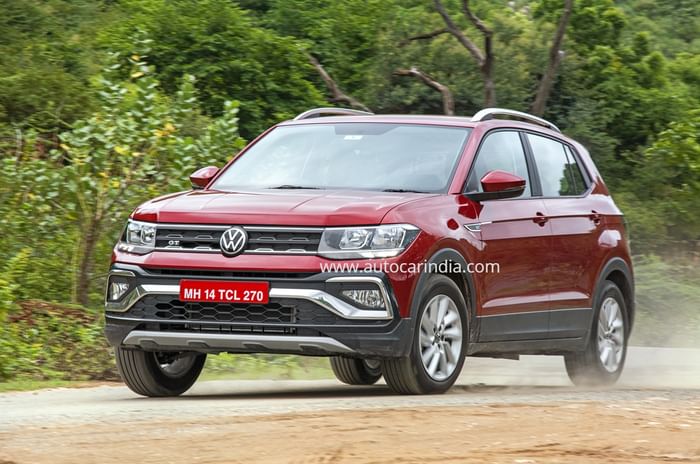
This MQB A0 IN platform is said to be 30 percent stiffer than the outgoing Polo’s platform, and the result is pretty evident when driving this SUV with verve. It tackles corners with great poise, in a very balanced manner, and feels very nimble from behind the wheel. The Taigun actually surprises you with the amount of grip it has around corners, and it doesn’t roll as much as you would have expected in a car in which you are sat relatively high above the ground. The steering is light, so it is nice and easy in the city, and it weighs up adequately at highway speeds.
Drive a Taigun on a winding road and the zesty engine and keen handling are sure to be the big takeaways for you.
Volkswagen Taigun: should you buy one?
So, should you be interested in the Taigun? If it's a big and beefy SUV you want, or will be travelling with all five seats occupied often, the Taigun won't be the right pick for you. That being said, the Taigun is a comfy 4-seater and it does look chic, both outside and inside. Yes, it's not as well equipped as its Korean rivals and there are some signs of cost-cutting too, but on the plus side, it feels as tough as you'd expect a German SUV to.
Where the Taigun really appeals is in the driving department. The 1.5-litre engine is strong, and coupled with the comfy ride and crisp handling, this a fun SUV to drive. The smaller-hearted Taigun 1.0 TSIs also promise good bang for your buck. We expect pricing in the range of Rs 10.5 -14 lakh (ex-showroom) for the 1.0 versions, while the 1.5 MT will likely start at Rs 15.5 lakh, with the range-topping DSG versions coming in at Rs 18 lakh.
Only a full blown comparison with rivals will tell us ultimately where the Taigun fits in, but if it's a solid, sophisticated and sporty midsize SUV you want, the Taigun could be the one for you.




































